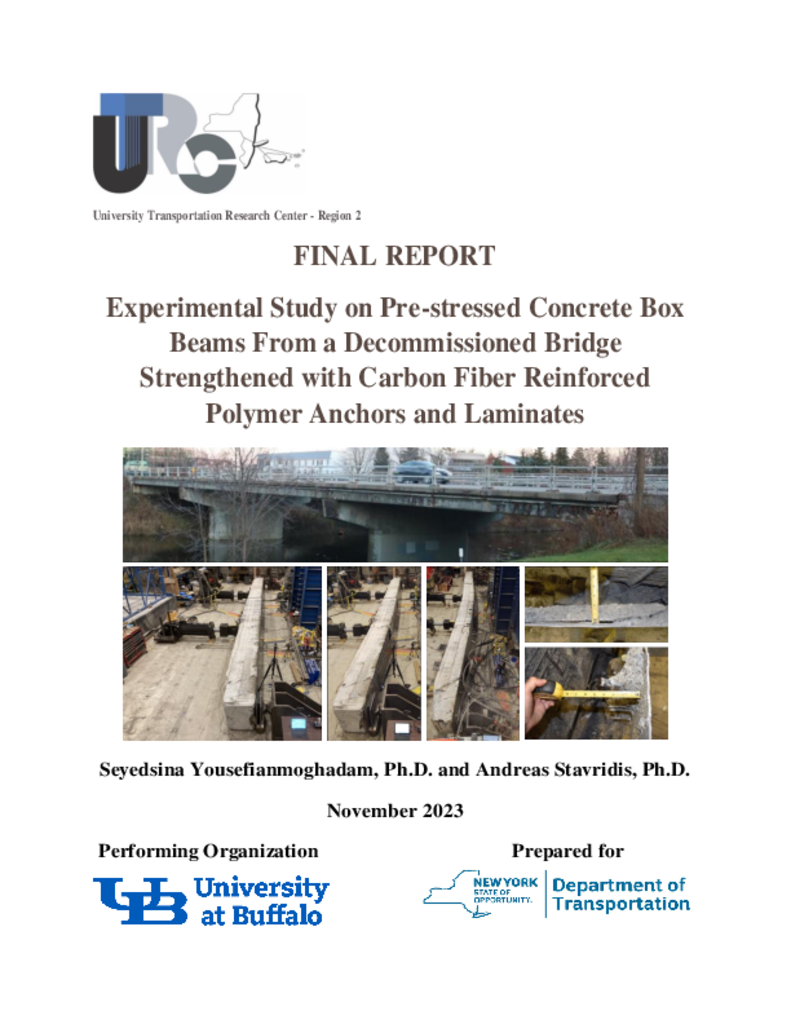This study addresses the need to increase the flexural capacity of deteriorated pre-stressed concrete
box beams through an experimental campaign involving the design, application, and testing of a
retrofit scheme. The retrofit scheme considered here involves the use of carbon fiber reinforced
polymer (CFRP) laminates which are attached to the beams using epoxy and CFRP anchors.
Three 57-ft long beams were obtained during the demolition of a bridge in Buffalo, NY. The bottom
surface of the beams was prepared for the application of the CFRP retrofit. Besides cleaning, the
surface preparation involved patching of cavities with epoxy, and grinding to increase the roughness
according to Technical Guideline No 310.2 of the International Concrete Repair Institute. Holes were
also drilled to allow the installation of the CFRP anchors. The anchor layout, as well as the laminate
thickness, varied between the three specimens to investigate their effect on the structural
performance. All beams were tested under service loads before being retrofitted to evaluate their
structural condition prior to the retrofit application. Once strengthened, they were tested to failure
with a four-point bending test set up using two 440-kip actuators.
The first beam included three layers of laminate, an anchor-to-laminate ratio of 0.5, and 14 anchors
distributed at the ends and the two quarter-length points of the beam where the sections were solid
concrete. The beam reached a moment 22% higher than the capacity of the unretrofitted beam. At
that load, the anchors and laminate pulled away due to the failure of the concrete cover, which
exposed the beam reinforcement.
The second beam included two layers of CFRP laminate, an anchor-to-laminate ratio of 0.8, and 14
anchors, distributed as in the case of the first beam on one end, but in three cross sections on the
other end. The beam reached a moment 46% higher than the capacity of the unretrofitted beam. Its
damage pattern included debonding of the laminate and failure of the concrete cover.
The third beam included a single layer of laminate, an anchor-to-laminate ratio of 1.2, and 14 anchors
located near the ends of the beam, but within the hollow section. This beam reached a moment 50%
higher than the moment capacity of the unretrofitted beam. The damage pattern was dominated by
the debonding and the subsequent fracture of the CFRP laminate. This beam exhibited the largest
ductility, as it reached a beam end rotation of 3.4 degrees, which corresponded to a displacement of
16 in. at the beam midspan.
This research provides much needed data for the behavior of deteriorated beams retrofitted
with CFRP laminates and anchors. The tests on the beams obtained from an actual bridge
after 37 years of service indicate the feasibility and effectiveness of the retrofit scheme.
They also demonstrate that differences in the retrofit, i.e. the laminate thickness and the
anchor distribution can lead to drastically different failure patterns. However, in all cases the
retrofit scheme increased the stiffness, and mainly the strength and ductility of the beams.
The increase in strength and ductility was larger after the application of smaller thickness of
FRP laminates.




